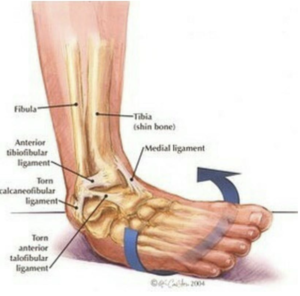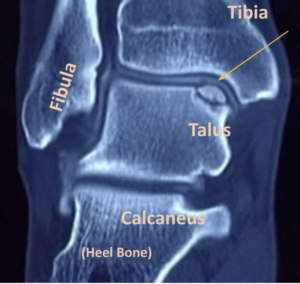ANKLE SPRAIN
If you’ve suffered from a serious ankle sprain, please Schedule an appointment with one of our orthopedic specialists as soon as possible.
 What is a Sprain?
What is a Sprain?
When the ankle forcefully twists or turns in an unnatural way, it causes sprained ankles. This movement damages or stretches the ligaments in the ankle joint, which stabilize the foot. Ligaments stabilize the foot and prevent movement beyond a standard range of motion. In most cases, ankle sprains tend to roll outwards, damaging the ligaments on the outer edge of the foot.
Ankle sprains come in a variety of grades depending on the severity of the injury, which also determines treatment options. Most cases of sprained ankles will heal on their own with rest and pain management medication, although patients should still consult with an orthopedic specialist to evaluate serious sprains and diagnose an appropriate treatment.
How Serious Is It?
At some point in our lives, we’ve all experienced a slight twist of an ankle, whether through sports, walking on an uneven surface, or simply from a slight misstep in heeled shoes. The more common mechanism of injury involves an inversion or plantarflexion sprain, affecting the lateral aspect of the ankle. This lateral side comprises three primary ligaments: the anterior talofibular ligament (ATFL), the calcaneofibular ligament (CFL), and the posterior talofibular ligament (PTFL). Mild to moderate ankle sprains often affect two of these three ligaments (see figure a). During a sprain, the ligaments stretch and may partially tear, triggering a cascade of inflammatory responses that lead to swelling and subsequent pain in the ankle.
In some cases, the ankle swells instantaneously and can be intolerable to walk on. In most instances, the injury will linger for several weeks. Resting, icing, compressing the ankle with a brace, and elevating the foot and ankle can alleviate the pain. Over-the-counter anti-inflammatory medications can prevent pain from worsening during the first few days of the injury.
High Ankle Sprains
Severe ankle sprain injuries may involve a high ankle sprain or a cartilage injury. In a high ankle sprain, the ligaments that hold the two long bones above the ankle, the tibia and the fibula, known as the ankle syndesmosis, completely tear. These ligaments include the anterior inferior tibiofibular ligament (AITFL) and the posterior inferior tibiofibular ligament (PITF). The stability of the ankle joint relies on these higher ankle joint ligaments.
A cartilage injury, also known as osteochondritis dessicans, is a fracture to the ankle cartilage causing a defect that is essentially analogous to a pothole on the surface of a road (Figure B). A fracture of the ankle cartilage often leads to significant pain, instability of the ankle, and early post-traumatic arthritis.

Fig A. A lateral ankle sprain demonstrating a tear of the anterior talofibular ligament and the calcaneofibular ligament, two of the most commonly affected.

Figure B. An osteochondral defect is demonstrated on advanced imaging as a fracture of the cartilage of the talus.
What is the difference between a sprain and a strain?
What are the casues and symptoms of a ankle sprain?
Pain, tenderness, limited motion, and weakness around the injured area. Sometimes the sprained area will swell and bruise. Some people may hear a pop in the joint at the time of injury.
A sprain occurs when you overextend or tear a ligament while severely stressing a joint. Additionally, Ankle sprains can occur when the ankle forcefully twists or turns in an unnatural way. This unnatural movement can damage or stretch the ligaments in the ankle joint that help stabilize the foot. For example, walking or exercising on an uneven surface or landing awkwardly from a jump can result in an ankle sprain.

 What is a Sprain?
What is a Sprain?